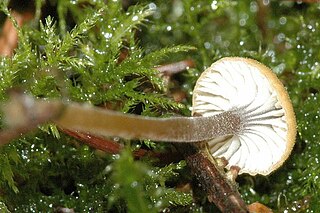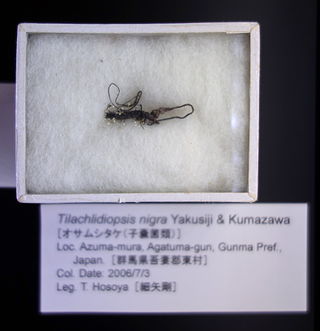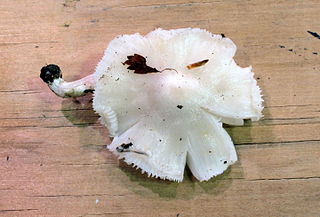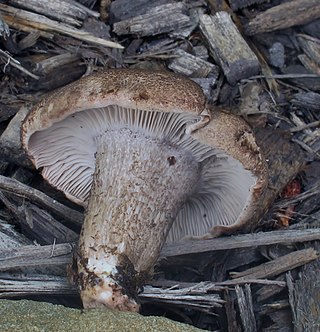| Mycoalvimia | |
|---|---|
| Scientific classification | |
| Kingdom: | |
| Phylum: | |
| Class: | |
| Order: | |
| Family: | |
| Genus: | Mycoalvimia (Singer) |
| Type species | |
| Mycoalvimia theobromicola Singer | |
Mycoalvimia is a genus of fungus in the family Tricholomataceae. It is a monotypic genus, and contains the single species Mycoalvimia theobromicola, found in Brazil. [1]

The Hygrophoraceae are a family of fungi in the order Agaricales. Originally conceived as containing white-spored, thick-gilled agarics, including Hygrophorus and Hygrocybe species, DNA evidence has extended the limits of the family, so it now contains not only agarics, but also basidiolichens and corticioid fungi. Species are thus diverse and are variously ectomycorrhizal, lichenized, associated with mosses, or saprotrophic. The family contains 34 genera and over 1000 species. None is of any great economic importance, though fruit bodies of some Hygrocybe and Hygrophorus species are considered edible and may be collected for sale in local markets.

The Tricholomataceae are a large family of fungi within the order Agaricales. Originally a classic "wastebasket taxon", the family included any white-, yellow-, or pink-spored genera in the Agaricales not already classified as belonging to e.g. the Amanitaceae, Lepiotaceae, Hygrophoraceae, Pluteaceae, or Entolomataceae.

Rickenella is a genus of brightly colored bryophilous agarics in the Hymenochaetales that have an omphalinoid morphology. They inhabit mosses on mossy soils, peats, tree trunks and logs in temperate regions of both the Northern and Southern Hemispheres. Phylogenetically related agarics are in the genera Contumyces, Gyroflexus, Loreleia, Cantharellopsis and Blasiphalia, as well as the stipitate-stereoid genera Muscinupta and Cotylidia. and the clavarioid genus, Alloclavaria.
Cantharellopsis is a tan- to whitish-colored bryophilous monotypic genus in the Hymenochaetales. The fruit bodies of the single species Cantharellopsis prescotii has a form intermediate between an Omphalina and a chanterelle (Cantharellus) because of its forked, fold-like gills. It inhabits moss on calcareous soils in temperate regions of Europe. Phylogenetically related agarics are in the genera Contumyces, Gyroflexus, Loreleia, Rickenella and Blasiphalia, as well as the stipitate-stereoid genera Muscinupta and Cotylidia and the clavarioid genus, Alloclavaria.

Collybia is a genus of mushrooms in the family Tricholomataceae. The genus has a widespread but rare distribution in northern temperate areas, and contains three species that grow on the decomposing remains of other mushrooms.
Callistodermatium is a fungal genus in the family Tricholomataceae. It is a monotypic genus, and contains the single species Callistodermatium violascens. The holotype was found in Brazil, and described by mycologist Rolf Singer in 1981.
Pegleromyces is a genus of fungi in the family Tricholomataceae. It is a monotypic genus, containing the single species Pegleromyces collybioides, found in Brazil, and described as new to science by mycologist Rolf Singer in 1981.
Arthrosporella is a fungal genus in the family Tricholomataceae. It is a monotypic genus, containing the single species Arthrosporella ditopa, found in South America. The genus was described by mycologist Rolf Singer in 1970.
Cynema is a genus of fungi in the family Tricholomataceae. This is a monotypic genus, containing the single species Cynema alutacea, found in Papua New Guinea.
Cyphellocalathus is a genus of fungi in the family Tricholomataceae. This is a monotypic genus, containing the single species Cyphellocalathus cecropiae, found in Bolivia.
Dennisiomyces is a genus of fungi in the family Tricholomataceae. Described by mycologist Rolf Singer in 1955, the genus contains five species found in South America.

Mycenella is a genus of fungi in the family Tricholomataceae. The widespread genus contains 10 species, found mostly in temperate regions. Mycologist Rolf Singer circumscribed the genus in 1938.
Physocystidium is a genus of fungi in the family Tricholomataceae. This is a monotypic genus, containing the single species Physocystidium cinnamomeum. This species is found in Trinidad, and was originally described as new to science in 1951 as Collybia cinnamomea by mycologist R.W.G. Dennis; Rolf Singer transferred it to the then newly created genus Physocystidium in 1962.

Tilachlidiopsis is a genus of fungi in the family Tricholomataceae. It is an anamorphic form of Collybia.

Nothoclavulina is a genus of fungus in the family Tricholomataceae. The genus is monotypic, containing the single species Nothoclavulina ditopa, described by American mycologist Rolf Singer in 1970. The species, found in Argentina, is an anamorphic version of the genus Arthrosporella. The generic name Nothoclavulina is Latin for "false Clavulina".

Albomagister is a genus of fungi in the family Tricholomataceae. The genus contains just one named species known from Tennessee and North Carolina, however two other undescribed species have been sequenced. Albomagister was described by mycologists Marisol Sánchez-García, Joshua Birkebak & P. Brandon Matheny in 2014 with Albomagister subaustralis as the type species.
Corneriella is a genus of fungi in the family Tricholomataceae. The genus contains two species known from the United States and Thailand, and at least four others have been detected by DNA sequencing. Corneriella was described the mycologist Marisol Sánchez-García in 2014 with Corneriella bambusarum as the type species.

Pseudotricholoma is a genus of fungi in the family Tricholomataceae. The genus contains three species known from North America. Europe, and the Azores. Basidiocarps resemble those of the genus Tricholoma, with a dry fibrillose pileus and white to brown lamellae that have adnate to emarginate attachment and stain reddish when damaged, eventually turning black. Microscopically, the basidiospores are smooth, ellipsoid to ellipsoid-oblong, thin-walled and amyloid. Cheilocystidia are rare to absent and pleurocystidia are absent. The pileipellis is a cutis and clamp connections are present. Species in Pseudotricholoma are found on soil in grasslands and woods. They are probably biotrophic, and may be ectomycorrhizal.
Pogonoloma is a mushroom genus in the family Tricholomataceae in a broad sense. The genus contains two species known from Europe. Pogonoloma was described first as a subgenus of the genus Porpoloma but recent molecular evidence separates the two by several other genera, with Porpoloma remaining within a smaller family Tricholomataceae.